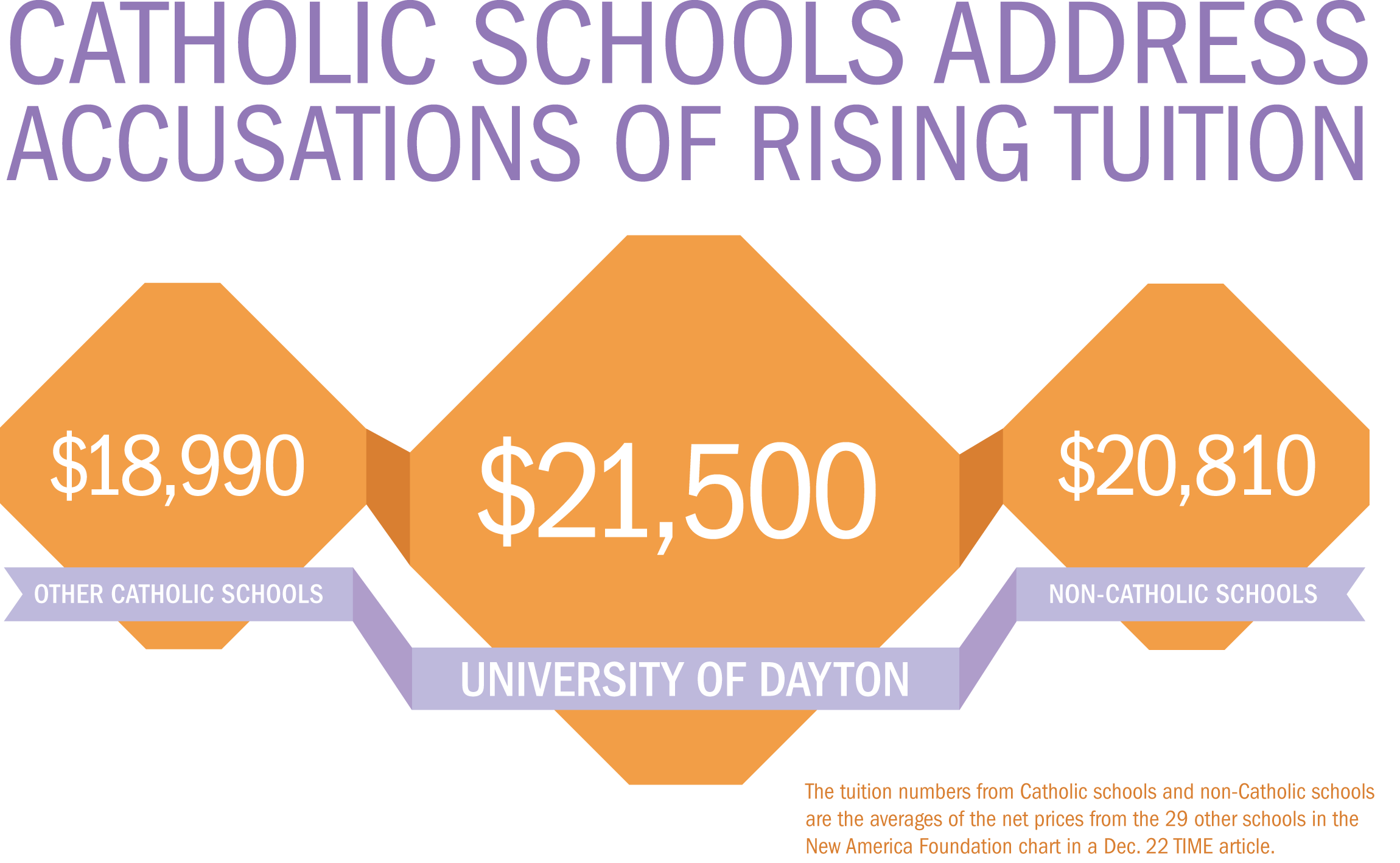CATHOLIC SCHOOLS ADDRESS ACCUSATIONS OF RISING TUITION
By: Dominic Sanfilippo – Staff Writer & Roger Hoke – News Editor
It’s almost February in America, which means that across the country, FAFSA forms, financial aid applications and tuition prices are sure to be on the minds of millions of high schoolers, college students and their families.
The rising costs of higher education and their subsequent burden on college students have been increasingly pointed to as a public problem in recent years. In late November, Bloomberg reported that the average growth in tuition prices had outpaced inflation rates yet again, continuing a “decades-long pattern.”
This argument resonates here at the University of Dayton and other Catholic institutions around the country on Dec., 22, 2014 when TIME magazine, in coordination with the Hechinger Report, published an article titled “Catholic Colleges Tell Poor Kids to Go Elsewhere.” The article cites a study from the New America Foundation, a nonpartisan public policy institute and think tank based in Washington, D.C., which shows that Catholic institutions are disproportionately represented in the list of colleges that have the highest net price for lower income students.
Out of the 30 institutions with the highest net tuition prices, which reflect actual costs after financial aid, scholarships and other discounts, 10 are Catholic. The University of Dayton is the eighth most expensive university on the chart, just behind Saint Louis University, a Jesuit institution.
Several of the universities’ endowments are contrasted with the net tuition chart, and quotes Dayton’s as $442 million, as of the 2011-2012 school year. In its 2014 financial report, the university’s endowment is listed at just over $518 million.
The article implies that these statistics, and the fact that many of the Catholic universities on the list have a low number of enrolled federal Pell Grant students, are troubling given the Catholic Church’s mission and commitment to the poor. It quotes a Villanova University theology professor, Gerald Beyer, who believes that Catholic institutions should fight to move against what he sees as a “preferential option for the rich” that has crept into financial decision-making at some private and Catholic colleges and universities nationwide.
Later on, the article does note that “the University of Dayton said that since the 2011-2012 school year covered by the New America study, it has instituted a four year guarantee that students’ net price won’t increase and has taken other steps that are beginning to result in more Pell students and less student debt.”
In interviews with Flyer News, Dayton administrators again pointed to the relatively new tuition structure as one of many changes since the 2011-2012 school year, and said that the Time article throws UD into the larger group without giving a clearer account of the university’s commitment to social justice, Catholic social teaching and affordability issues.
“The University of Dayton is completely concerned about trends in affordability that affect low-income students,” said Sundar Kumarasamy, the university’s vice president of Enrollment Management.
“We are the only national Catholic university that offers a four-year, net-price guarantee to all incoming first-year students,” Kumarasamy said. “In brief, the plan eliminates many of the hidden costs of an education that often surprise families, especially first-generation college-going families, and can add significantly to the cost of a degree.”
Kathy Harmon, the University of Dayton’s Dean of Admission and Financial Aid, echoed this sentiment.
“I don’t think it paints the whole picture,” Harmon said. “There are 916 students receiving Pell Grants, out of over 7,000 undergraduates.”
Harmon went on to state that UD awards alternative aid to many students who are not eligible for Pell Grants, such as refugees from foreign countries, and those who are just out of the financial zone of being eligible for such aid. Pell Grants are typically awarded to households whose annual income is around or under $30,000.
“I think that to make an assumption that [the University of Dayton] only cares about attracting wealthy, affluent students is wrong,” Harmon said.
“As a Catholic university, we have a moral responsibility to be transparent about the real cost of a four-year degree because our families must make a substantial investment that often includes significant borrowing for their students’ educations,” said Kumarasamy. “Further, we are mindful that preferential option for the poor is a pillar of Catholic social teaching and our own Marianist charism of community.”
There is no doubt that further discussion and reflection about the difficult reality of the costs of higher education will continue in living rooms, classrooms, and board meetings both on UD’s campus and nationwide in the months and years ahead. What’s truer still is that students themselves are increasingly becoming a vocal part of the dialogue.
“I believe that we, as a university, need to continue to help the poor while also helping the middle class, which we appear to mostly serve,” Joshua Tovey, the director of Marianist involvement of UD’s Student Government Association, said. “This task is one that we, and the next president of the university in 2016, will have to balance and pray about.”


